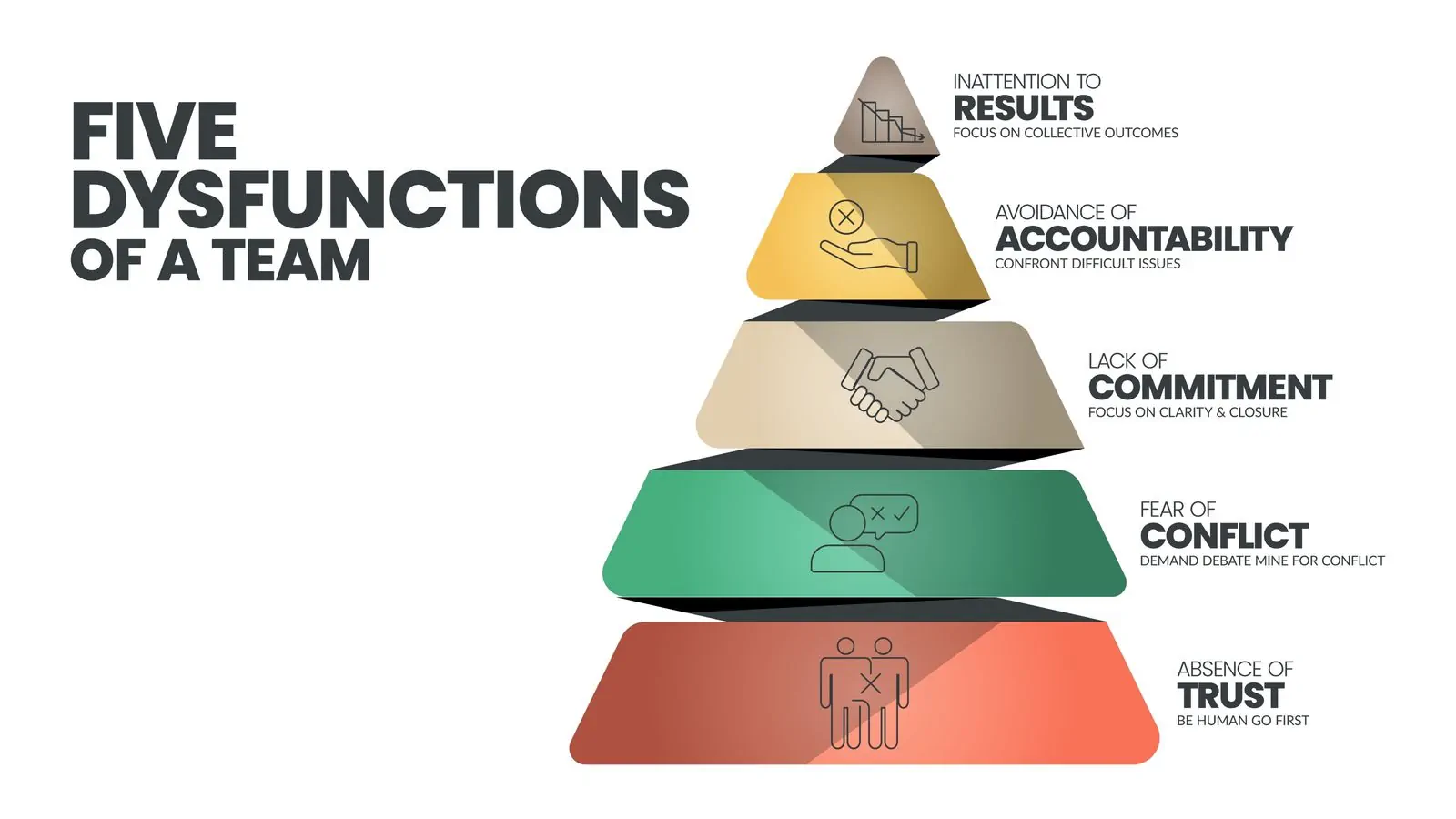Conflict in the workplace is not new, but it’s getting worse. According to a 2022 Myers-Briggs Company study, the time spent on workplace conflicts has risen 100% since 2008. In another study, 94% of participants said they worked alongside toxic individuals within the past five years. A survey led by the Society for Human Resource Management in 2019 found that 20% of US workers quit their jobs purely because of workplace toxicity. The same report also revealed that around 50% of staff considered following suit. [1] [2] [3]
Understanding the costs and consequences of work-related tensions is critical for effective conflict resolution and workplace harmony. So, what causes this discord, and what can project managers do to resolve these challenges?
This article explores it all, from clashing personalities to conflicting ideas. It looks at how different personality types face the fire, from avoiders to collaborators, and the approaches used to cool things down. But first, an overview of the cost of conflict in the workplace as it pertains to the new American workforce.
Understanding the Cost of Conflicts in the Workplace
The first inclusive data on the cost of workplace disputes was from a 2008 investigation conducted by HR consulting firm CPP Global. The study found that workers spent 2.8 hours per week grappling with work-related conflicts, representing an estimated $359 billion in lost paid hours annually. With rising inflation, higher hourly wages, and a workforce with evolving needs, we can expect this cost to be significantly higher today. [4]
The Myers-Briggs Company has recently followed up on CPP’s workplace conflict report. The new paper entitled Conflict at Work has some interesting findings. [5]
The Face of Modern Workplace Conflicts
Workplace conflicts typically erupt when the needs and desires of employees clash. Frictions can manifest in various ways, from simmering resentments to heated arguments and even all-out fights. There are many nuances to workplace tensions, but recent data points to prominent causes. The type of conflict also differs depending on the work environment (in-office, remote, or hybrid), the industry, the company culture, and personal situations.
The chart below highlights the 10 most common causes of workplace conflicts as of 2022.

Data source: Myers-Briggs Company Conflict at Work Report
There are other, less impactful causes for discord. Some of those are inadequate training opportunities, poor management, mismatched hiring, and unfair treatment.
What About Bullying?
Bullying has always existed in various forms within US workplace cultures. Still, it has only recently garnered recognition as a distinct problem that needs special attention. This phenomenon encompasses a range of behaviors, including aggression, intimidation, harassment, and victimization. Bullying is a major concern, but it’s not isolated as a separate category, as it often overlaps with other types of conflicts mentioned above.
Worth noting is a 2021 WBI US Workplace Bullying survey. Researchers found that 49% of US workers were affected by bullying, either through direct experience (30%) or witnessing it happening to others (19%). The survey also revealed that 66% of participants were aware of bullying issues in their place of work. [6]
Let’s now discuss the 10 causes of workplace clashes and the strategies to resolve them.
Workplace Conflicts and Solutions
Good leaders address workplace conflicts early to prevent escalation and maintain positive relationships. Swift intervention results in enhanced productivity, open and honest dialogue, and improved morale, reducing stress and the potential for legal issues. Managers who handle conflicts effectively enjoy harmonious work environments that actively promote employee well-being and maintain a positive reputation within the organization. Conversely, unresolved conflicts hinder productivity and can significantly damage team dynamics.
This section highlights the issues and shows how you can prioritize conflict resolution in the workplace to help create spaces that foster open communication and empathy.
Effective Conflict Resolution Strategies for Leaders
Workplace conflicts are inevitable but also provide opportunities for growth, collaboration, and unity when handled constructively. This piece aims to help managers and emerging leaders recognize and address common workplace disputes in a constructive way that contributes to a thriving and unified workplace.
Customizing strategies for conflict disagreements is a pragmatic approach. Even so, keep in mind these five fundamental techniques that universally contribute to prompt and effective conflict resolutions regardless of cause:
- Address the issue promptly
- Manage emotions effectively
- Demonstrate empathy
- Engage in active listening
- Acknowledge criticism
Additionally, be mindful of Glaser’s 3-step conflict resolution strategy:
- Understand worker perspectives
- Admit your part in the problem
- Revisit the conversation if initial attempts prove unsuccessful [7]
#1 Poor Communication (47%)
Around 90% of business leaders say they have experienced the negative effects of poor communication. It’s now the principal cause of workplace conflicts and financial setbacks. Inadequate communication tools, a lack of transparency, and ineffective leadership are among the primary culprits. Breakdowns in communication can impede productivity, erode company culture, and hinder teamwork. A recent study by Harris Poll commissioned by Grammarly estimated that communication breakdowns cost US businesses a staggering $1.2 trillion annually. [8]
This table summarizes the effects poor communication has on workers and organizations.
| Poor Communication Effects | Workers | Organizations |
| Misunderstandings | Decreased morale | Reduced productivity |
| Lack of clarity | Increased stress | Inefficient workflows |
| Low team cohesion | Frustration and confusion | Hindered decision-making |
How to Resolve Communication Conflicts
Establish effective communication channels that align with your organization’s needs. Regularly provide constructive feedback and recognition to boost worker morale and engagement. Build transparency by sharing relevant information openly and honestly. Engage in active listening, asking open-ended questions that encourage dialogue. Address conflicts constructively and encourage collaborative problem-solving to improve workplace harmony.
By following these simple strategies, you will strengthen team dynamics and build more resilient employee relationships.
#2 Role Ambiguity (42%)
The lack of role clarity is the second leading cause of workplace tensions and conflicts. It has negative influences on workers and organizations.
| WORKER IMPACT | COMPANY IMPACT |
| Stress & Anxiety: Vague expectations and duties cause undue worker stress and anxiety.
Low Morale: Unclear roles and responsibilities lead to demoralization and job dissatisfaction. Diminished Output: Unclear expectations impact worker productivity and work quality. Frictions and Disagreements: Role ambiguity causes conflicts and tension among workers, creating negative work environments. |
Slowed Productivity: Fuzzy responsibilities and roles lower organizational performance.
Elevated Expenditure: Ambiguous roles waste valuable time and precious resources. Declining Motivation: Unclear responsibilities disengage workers, lower job satisfaction, and negatively impact retention rates. Stagnant Innovation: Lack of role clarity stifles workforce innovation and creativity. Increased Turnover: Unhappy workers soon quit, resulting in high turnover rates and increased recruitment costs. |
How to Resolve Role Clarity Conflicts
To encourage innovation and avoid conflicts due to unclear roles, set team objectives that are aligned with your organization’s strategy. Clearly communicate individual roles, tasks, and expectations to facilitate open dialogue, feedback, and support. Regularly review and adjust positions as necessary to maintain clarity and stimulate creativity.
#3 Heavy Workloads (38%)
No one appreciates feeling overworked and burdened with unreasonable demands. Over time, this can lead to resentment, especially when unmanageable, unfair workloads become the norm. Excessive responsibilities often fuel workplace conflicts, as employees overwhelmed by their tasks are more likely to lash out or become withdrawn.
Leaders should know that excessive workloads can increase the risk of poor performance, safety hazards, critical errors, and absenteeism.
How to Resolve Heavy Workload Disputes
To prevent conflicts arising from heavy workloads, define specific roles and responsibilities to avoid confusion and overlap. Critically evaluate and optimize task distribution across teams and shifts. Also, assess the physical and mental demands of each task as you analyze work volume and assign duties. Additionally, involve workers in task analysis to foster buy-in and ownership, as this helps create a more engaged and efficient team.
#4 Personality Clashes (37%)

Research from 2020 suggests that organizations with highly politicized climates often trigger workplace conflicts. Leadership failures to manage interpersonal relationships effectively exacerbate situations. [9]
While the causes of personality clashes are manifold, most disrupt workplace harmony to some degree. Many conflicts of character stem from incompatible traits, backgrounds, or differing viewpoints among coworkers. These differences might result in heated workplace disagreements, snubbing, mistrust, and gossip. When left to fester, you will see a notable decline in overall productivity at individual or team levels.
————————————————————————————————————-
Resolve Personality Clashes with EWF Lumina Spark Assessments
Lumina Spark profiles empower leaders to navigate character conflicts effectively. EWF’s detailed assessments unlock self-awareness and insights by revealing strengths, leadership styles, and potential for growth. We equip you with the knowledge and tools needed to de-escalate conflicts, build bridges, and foster positive and productive work environments. These 40-page profile assessments reveal leadership styles and personality traits without labels or stereotypes.
Request More Info on the Lumina Spark Assessment Here
————————————————————————————————————-
#5 Workplace Changes Cause Conflicts (30%)
Even minor workplace changes can cause employees to feel vulnerable and uncertain about job security and career prospects. Individuals and teams are less likely to embrace change when they’re not given the full picture of what it all means. Familiar habits bring comfort, while fear of the unknown can spark resistance, leading to conflict among the ranks.
How to Smooth Organizational Change
A business is only as sick as its secrets. Therefore, smooth workplace transitions are achieved through transparent communication about the reasons for change. Effective leaders involve all team members in their communication and provide training where needed. When your teams feel valued and prepared, conflicts stemming from change are significantly minimized, resulting in a calm, open environment conducive to growth.
#6 Dysfunctional Teams (27%)
Patrick Lencioni highlights the Five Dysfunctions of a Team in his 2002 book.

A University of Phoenix survey found that 70% of workers have been part of dysfunctional teams. [10] Communication breakdowns, low morale, resistance, blame, and missed deadlines are common signs of a chaotic team. Beneath the surface lie deeper issues, e.g., a lack of trust, fear of open conflict, and a general disregard for shared common goals.
Identifying dysfunctions isn’t hard once you know what to look for. The telltale signs are silos (lack of communication), top-down decision-making (HiPPO principle), and artificial harmony, which basically means avoiding honest and open discussions.
How to Resolve Dysfunctional Team Conflicts
Transforming a dysfunctional team starts by looking at the roots of disruption. Cultivating trust is critical from the outset. It requires leaders to embrace self-examination and welcome constructive feedback from others. The strategy is to unravel and tackle issues such as leadership gaps, unclear roles, bias, and favoritism. Don’t hesitate to leverage behavioral data for insights if you have access to it. If mistrust within the team persists, involve human resources (HR) for interpersonal issues beyond managerial resolution.
#7 Ethical Divisions (25%)
The 2018 report on ethics and compliance in the US workplace suggests a need for greater ethical awareness and practices. Clashing values spark tensions not only among workers and teams but also between employees and an organization’s ethical policies. These conflicts can breed resentment, particularly when people feel forced to choose between ethical behavior and achieving other priorities. A lack of buy-in into organizational ethics can further amplify these conflicts. [11]
Ethical spats go beyond concepts such as religion, culture, and politics. In the contemporary context, workplace disagreements often manifest in quarrels over environmental practices, medical ethics, social justice movements, and company policies. In the run-up to elections, it’s common for political disputes to boil over. Furthermore, information technology, privacy, and economic beliefs add fuel to the fire.
A 2021 poll conducted on LinkedIn by Bruce Weinstein, Ph.D., on the role of ethics in the future workplace saw a significant emphasis on its importance.

Data source: Forbes
Resolving Worker Conflicts Around Differing Values
It’s possible to find mutual agreement with the right approach. The aim is to create and maintain a culture of respect where common ground is established through shared values and goals. Consider these six points as you approach disputes around differing values:
- Recognize the origin of the conflict
- Honor and appreciate diversity
- Engage in clear and productive communication
- Foster innovative collaboration
- Extract valuable lessons from the encounter
- Ask for assistance when needed
Through richer conversations, individuals and teams build a better understanding and develop collaborative solutions that foster a culture welcoming differing viewpoints.
#8 Resource Scarcity (24%)
Resource scarcity is another cause of workplace conflicts. It’s especially problematic when tight deadlines exist, and employees must vie for the limited resources to do their job. [12] The potential for discord is higher when workers see favoritism through unfair workloads and resource allocation. Scarce resources can result in decreased productivity, low morale, high turnover, and a negative impact on client satisfaction.
How to Resolve Resource-Related Conflicts
Addressing resource-related issues is vital for a harmonious workplace. The solution is transparency and collaboration. Leaders must clearly communicate resource limitations and promptly address any workload imbalances. Most important is to view these issues as a collective challenge, inviting team input on prioritizing tasks and optimizing workflows. Empowering teams in this way unleashes problem-solving creativity and builds camaraderie.
#9 Lack of Transparency (23%)
A lack of transparency fuels gossip and whispers, breeding assumptions, misunderstandings, and mistrust. These are the ingredients that ultimately lead to conflicts. Unfortunately, the modern workspace amplifies transparency challenges further. This is especially true regarding remote or hybrid setups, where communication can be somewhat limited, distorted, and exacerbated by different time zones.
Resolving Conflicts Caused by Ambiguity
Transparent communication is critical for building trust and creating a culture of emotional well-being in the workplace. [13] Strive to be transparent and foster open communication channels. Provide regular updates and involve employees in decision-making processes. These straightforward measures help prevent further misunderstandings and conflicts.
#10 Inferior Senior Leadership Practices (19%)

Inferior senior leadership creates a breeding ground for workplace discord.
When leaders fail to communicate effectively, establish clear goals, or assert authority, employees may feel undervalued and demoralized. Potential conflicts can emerge as unhealthy rivalries between teams, leading to individual frustration and resentment. These issues significantly impact worker morale, resulting in a decline in creativity, innovation, and even customer satisfaction. The long-term consequences extend to employee well-being. A lack of effective communication and direction not only hampers productivity due to high turnover rates but also facilitates a toxic workplace culture.
How to Resolve Inferior Senior Leadership
Invest in talent—especially emerging leaders—to resolve conflicts triggered by inadequate leadership. Focusing on transactional leadership styles through skill development will help settle them into evolving roles with renewed knowledge and confidence. Encourage conflict resolution training, stress the value of feedback, and promote motivational oversight. By fostering positive change, your organization can salvage talent and secure its success.
————————————————————————————————————-
Unlock Leadership Potential with EWF’s Emerging Leaders Program
Empower your rising talent with the EWF Emerging Leaders Program. Through dynamic sessions, assessments, and workshops, participants gain effective conflict resolution expertise, strategic decision-making skills, and business acumen, ensuring they thrive in the modern workplace.
Explore the EWF Emerging Leaders Program
————————————————————————————————————-
Concluding Thoughts
From worker clashes to conflicting ideas, disputes permeate US workspaces. This article explored the nuances, causes, and resolutions of modern-day tensions, from better communication to stronger leadership. Assuming conflict resolution in all workplace setups enhances team dynamics, boosts productivity, and fosters more open dialogue, leading to greater workplace harmony. Transparency, effective communication, and leadership growth support emerging leaders in navigating this ever-complex landscape.
Remember, proactive resolution builds a unified and thriving workplace, propelling both employee well-being and organizational success.
————————————————————————————————————-
Resource Links
- https://www.themyersbriggs.com/time-spent-on-workplace-conflict-doubles/
- https://hbr.org/toxic-colleagues/
- https://www.shrm.org/toxic-workplace-cultures/
- https://img.en25.com/CPP/conflict-report/
- https://www.themyersbriggs.com/conflict-at-work-report/
- https://workplacebullying.org/wbi-bullying-survey/
- https://goodpractice/Glasers-3-Step-conflict-resolution-strategy/
- https://www.grammarly.com/business/poor-communication-study/
- https://www.researchgate.net/politicized-climates-trigger-workplace-conflicts/
- https://www.prnewswire.com/university-of-phoenix-survey/
- https://www.ethics.org/State-Ethics-Compliance-in-Workplace/
- https://hr.ou.edu/resource-scarcity/
- https://mediaspace.msu.edu/transparent-communication-is-critical/



